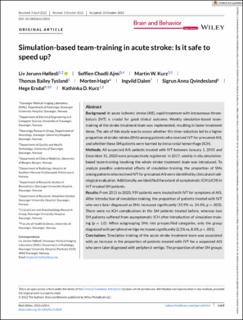| dc.contributor.author | Høllesli, Liv Jorunn | |
| dc.contributor.author | Ajmi, Soffien Chadli | |
| dc.contributor.author | Kurz, Friedrich Martin Wilhelm | |
| dc.contributor.author | Tysland, Thomas Bailey | |
| dc.contributor.author | Hagir, Morten | |
| dc.contributor.author | Dalen, Ingvild | |
| dc.contributor.author | Qvindesland, Sigrun Anna | |
| dc.contributor.author | Ersdal, Hege Langli | |
| dc.contributor.author | Kurz, Kathinka Dæhli | |
| dc.date.accessioned | 2023-04-03T08:50:28Z | |
| dc.date.available | 2023-04-03T08:50:28Z | |
| dc.date.created | 2022-11-24T12:16:54Z | |
| dc.date.issued | 2022 | |
| dc.identifier.citation | Høllesli, L. J., Ajmi, S. C., Kurz, M. W., Tysland, T. B., Hagir, M., Dalen, I., ... & Kurz, K. D. (2022). Simulation‐based team‐training in acute stroke: Is it safe to speed up?. Brain and Behavior, e2814. | en_US |
| dc.identifier.issn | 2162-3279 | |
| dc.identifier.uri | https://hdl.handle.net/11250/3061689 | |
| dc.description.abstract | Background
In acute ischemic stroke (AIS), rapid treatment with intravenous thrombolysis (IVT) is crucial for good clinical outcome. Weekly simulation-based team-training of the stroke treatment team was implemented, resulting in faster treatment times. The aim of this study was to assess whether this time reduction led to a higher proportion of stroke mimics (SMs) among patients who received IVT for presumed AIS, and whether these SM patients were harmed by intracranial hemorrhage (ICH).
Methods
All suspected AIS patients treated with IVT between January 1, 2015 and December 31, 2020 were prospectively registered. In 2017, weekly in situ simulation-based team-training involving the whole stroke treatment team was introduced. To analyze possible unintended effects of simulation training, the proportion of SMs among patients who received IVT for presumed AIS were identified by clinical and radiological evaluation. Additionally, we identified the extent of symptomatic ICH (sICH) in IVT-treated SM patients.
Results
From 2015 to 2020, 959 patients were treated with IVT for symptoms of AIS. After introduction of simulation training, the proportion of patients treated with IVT who were later diagnosed as SMs increased significantly (15.9% vs. 24.4%, p = .003). There were no ICH complications in the SM patients treated before, whereas two SM patients suffered from asymptomatic ICH after introduction of simulation training (p = 1.0). When subgrouping SMs into prespecified categories, only the group diagnosed with peripheral vertigo increased significantly (2.5% vs. 8.6%, p < .001).
Conclusions
Simulation training of the acute stroke treatment team was associated with an increase in the proportion of patients treated with IVT for a suspected AIS who were later diagnosed with peripheral vertigo. The proportion of other SM groups among IVT-treated patients did not change significantly. No sICH was detected in IVT-treated SM patients. | en_US |
| dc.language.iso | eng | en_US |
| dc.publisher | Wiley | en_US |
| dc.rights | Navngivelse 4.0 Internasjonal | * |
| dc.rights.uri | http://creativecommons.org/licenses/by/4.0/deed.no | * |
| dc.title | Simulation-based team-training in acute stroke: Is it safe to speed up? | en_US |
| dc.type | Peer reviewed | en_US |
| dc.type | Journal article | en_US |
| dc.description.version | publishedVersion | en_US |
| dc.rights.holder | The authors | en_US |
| dc.subject.nsi | VDP::Medisinske Fag: 700 | en_US |
| dc.source.pagenumber | 8 | en_US |
| dc.source.journal | Brain and Behavior | en_US |
| dc.identifier.doi | 10.1002/brb3.2814 | |
| dc.identifier.cristin | 2079994 | |
| cristin.ispublished | true | |
| cristin.fulltext | original | |
| cristin.qualitycode | 1 | |

